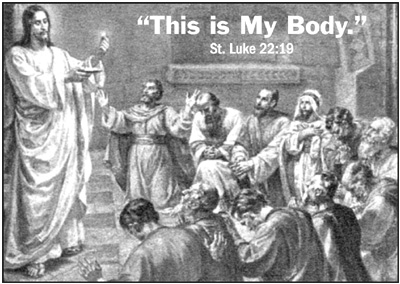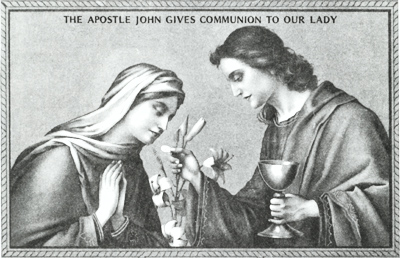|
Sign
of Reverence
“The Church has always required from the faithful respect and
reverence for the Eucharist at the moment of receiving it. . . .
“When
the faithful communicate kneeling, no other sign of reverence towards
the Blessed Sacrament is required, since kneeling is itself a sign of
adoration.”
Inaestimabile
Donum
Pope John Paul II, April 17, 1980
Genuflection
“The venerable practice of genuflecting before the Blessed Sacrament,
whether enclosed in the tabernacle or publicly exposed, as a sign of
adoration, is to be maintained.”
Inaestimabile Donum
Pope John Paul II, April 17, 1980
Transubstantiation
“The way Christ is made present in this Sacrament is none other than
by . . . this unique and truly wonderful change the Catholic Church
rightly calls transubstantiation. . . . Since after the change of the
substance or nature of the bread and wine into the Body and Blood of
Christ, nothing remains of the bread and wine but the appearances, under
which Christ, whole and entire, in His physical reality is bodily
present. . . .
“For
this reason the Church took special care to warn the faithful that in
reflecting on this most august Sacrament, they
should not trust to their senses, which reach only the properties of
bread and wine, but rather to the words of Christ which have power to
transform, change and transmute the bread and wine into His Body and
Blood. For the power that accomplishes this is that same power by which
God Almighty, at the beginning of time, created the world out of
nothing.
“We
have been instructed in these matters and filled with an unshakable
faith,” says St. Cyril of Alexandria, . . . “that that which seems
to be bread, is not bread, though it tastes like it, but the Body of
Christ, and that which seems to be wine, is not wine, though it too
tastes as such, but the Blood of Christ.”
Mystery of Faith
Pope Paul VI, September 3, 1965
Dispositions
“He who approaches the Holy Table should do so, not out of routine, or
vainglory, or human respect, but for the purpose of pleasing God, or
being more closely united with Him by charity, and of seeking this
divine remedy for his weaknesses and defects.
“Those
who communicate frequently or daily should be free from . . . mortal
sin, with the purpose of never sinning mortally in the future. . . .
“The
Sacraments . . . produce a greater effect in proportion as the
dispositions of the recipient are better; therefore, care is to be taken
that Holy Communion be preceded by serious preparation, and followed by
a suitable thanksgiving according to each one’s strength,
circumstances, and duties.”
Decree on Dispositions
for Daily Communion
Pope St. Pius X, December 20, 1905
Thanksgiving
“When the Mass . . . is over, the person who has received Holy
Communion is not thereby freed from his duty of thanksgiving; rather . .
. [he] should recollect himself, and in intimate union with the Divine
Master hold loving and fruitful converse with Him.”
Mediator Dei
The Integral Worship of the Mystical Body of Jesus Christ
Pope Pius XII, November 20, 1947
|
|
Faith
and Reason
“We must approach especially this mystery with humble respect, not
following human arguments, which ought to be silent, but adhering firmly
to divine revelation.
“St.
John Chrysostom . . . expressed these most fitting words: ‘Let us
submit to God in all things and not contradict Him, even if what He says
seems contrary to our reason and intellect; rather let His words prevail
over our reason and intellect. Let us act in this way with regard to the
(eucharistic) mysteries, looking not only at what falls under our senses
but holding on to His words. For His word cannot lead us astray’. . .
.
“St.
Cyril says: ‘Do not doubt whether this is true, but rather receive the
words of the Savior in faith, for since He is the truth, He cannot lie.’”
Mystery of Faith
Pope Paul VI, September 3, 1965
Manner
of Receiving
“[Communion on the tongue] rests upon a tradition of many centuries”
and “is a sign of the reverence of the faithful toward the Eucharist.
The practice in no way detracts from the personal dignity of those who
approach this great sacrament and it is a part of the preparation needed
for the most fruitful reception of the Lord’s body. . . .
“In
addition, this manner of communicating . . . gives more effective
assurance that Holy Communion will be distributed with the appropriate
reverence, decorum, and dignity; that any danger of profaning the
Eucharistic species, in which the whole and entire Christ, God and man,
is substantially contained and permanently present in a unique way, will
be avoided; and finally that the diligent care which the Church has
always commended for the very fragments of the consecrated bread will be
maintained. . . .
“[Communion
in the hand carries with it certain dangers.] They are a lessening of
reverence toward the noble sacrament of the altar, its profanation, or
the adulteration of correct doctrine.”
Memoriale Domini
Instruction on the Manner of Administering Holy Communion, issued by the
Vatican, the Congregation for Divine Worship
Pope Paul VI, May 29, 1969
Not
to Touch
“It is not permitted that the faithful should themselves pick up the
consecrated bread and the sacred chalice, still less that they should
hand them from one to another."
Inaestimabile Donum
Pope John Paul II, April 17, 1980
Priest
to Distribute
“A reprehensible
attitude is shown by those priests who, though present at the
celebration, refrain from distributing Communion.”
Inaestimabile Donum
Pope John Paul II, April 17, 1980
Priest’s
Duty
“The dispensing of Christ's body belongs to the priest for three
reasons. First, because . . . he consecrates as in the person of Christ.
But as Christ consecrated His body at the supper, so also He gave it to
others to be partaken of by them. Accordingly, as the consecration of
Christ's body belongs to the priest, so likewise does the dispensing
belong to him. Secondly, because the priest is the appointed
intermediary between God and the people; hence as it belongs to him to
offer the people's gifts to God, so it belongs to him to deliver
consecrated gifts to the people. Thirdly, because out of reverence
towards this sacrament, nothing touches it, but what is consecrated;
hence the corporal and the chalice are consecrated, and likewise the
priest's hands, for touching this sacrament. Hence it is not lawful for
anyone else to touch it except from necessity, for instance, if it were
to fall upon the ground, or else in some other case of urgency.”
Summa Theologica, Pt.
3, Q. 82, Art. 3
St. Thomas Aquinas, Doctor of the Church
Respect
for Ones Conscience in Upholding Tradition
“[A person] is not to be forced to act in a manner contrary to his
conscience. Nor, on the other hand, is he to be restrained from acting
in accordance with his conscience, especially in matters religious.”
Second Vatican Council
Declaration on Religious Freedom, ch. 3
December 7, 1965
|


